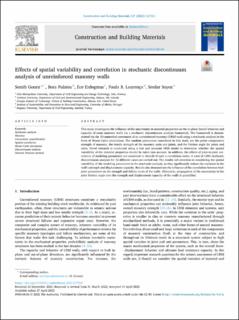Effects of spatial variability and correlation in stochastic discontinuum analysis of unreinforced masonry walls
Peer reviewed, Journal article
Published version
Permanent lenke
https://hdl.handle.net/11250/3011130Utgivelsesdato
2022-04-27Metadata
Vis full innførselSamlinger
Originalversjon
Construction and Building Materials. 2022, 337 127511-?. https://doi.org/10.1016/j.conbuildmat.2022.127511Sammendrag
This study investigates the influence of the uncertainty in material properties on the in-plane lateral behavior and capacity of stone masonry walls via a stochastic discontinuum analysis framework. The framework is demonstrated via the 3D numerical assessment of an unreinforced masonry (URM) wall using a stochastic analysis in the form of Monte Carlo simulations. The random parameters considered in this study are the prism compressive strength of masonry, the tensile strength of the masonry units and joints, and the friction angle for joints and units. Novel research is conducted using a fast and accurate DEM model to determine whether the spatial variability of the material properties should be taken into account. In addition, the effects of joint-to-joint correlation of modeling parameters are examined to identify if such a correlation exists. A total of 1200 stochastic discontinuum analyses for 12 different cases are carried out. The results call attention to considering the spatial variability of the modeling parameters in the stochastic analysis, as they significantly reduce the variation in the wall’s strength and displacement capacity. Results also demonstrate the influence of the correlation between bedjoint parameters on the strength and failure mode of the walls. Ultimately, propagation of the uncertainty in the joint friction angle into the strength and displacement capacity of the walls is quantified.

